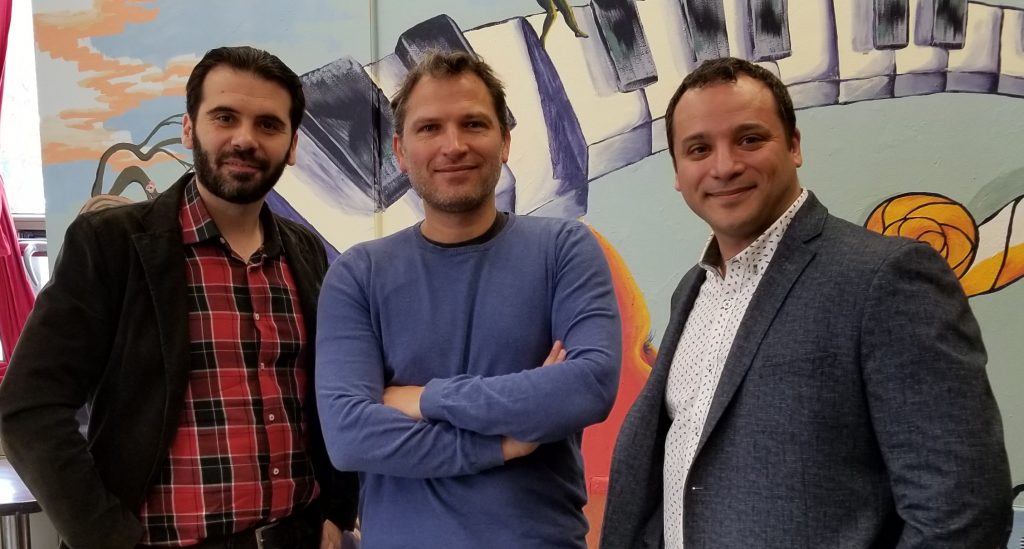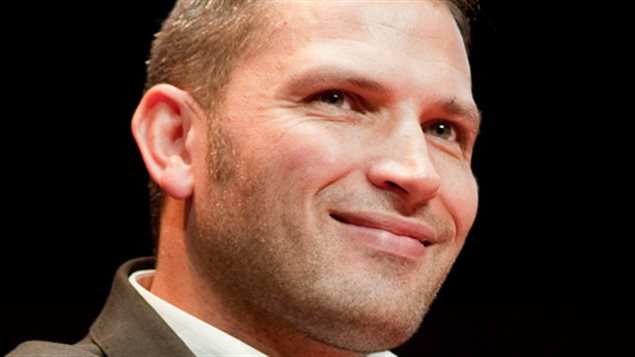 Interview with Drs. Karim Jerbi & Étienne Combrisson
Interview with Drs. Karim Jerbi & Étienne Combrisson
On April 9, 2018, Dr. Karim Jerbi, PhD, and Étienne Combrisson, PhD, met with Dr. Nikola Stikov and I at the University of Montreal for a short interview to discuss their work, and their co-authored research article entitled “From intentions to actions: Neural oscillations encode motor processes through phase, amplitude and phase-amplitude coupling”.
 Dr. Jerbi, Karim hereafter, is the head of the Cognitive & Computational Neuroscience Lab (CoCoLab) of the Psychology Department of the University of Montreal. The main goal of his research is to further our knowledge of brain function and dysfunction. He is particularly interested in gaining additional insight on how distinct neuronal populations exchange information and coordinate their activity across brain networks. Understanding the mechanisms of brain connectivity, and how they mediate information integration and processing, is in his opinion probably one of the most fascinating endeavors in systems neuroscience today. The research in his lab seeks to address these questions using a combination of techniques ranging from state-of-the-art neuroimaging, advanced signal processing, and machine learning tools.
Dr. Jerbi, Karim hereafter, is the head of the Cognitive & Computational Neuroscience Lab (CoCoLab) of the Psychology Department of the University of Montreal. The main goal of his research is to further our knowledge of brain function and dysfunction. He is particularly interested in gaining additional insight on how distinct neuronal populations exchange information and coordinate their activity across brain networks. Understanding the mechanisms of brain connectivity, and how they mediate information integration and processing, is in his opinion probably one of the most fascinating endeavors in systems neuroscience today. The research in his lab seeks to address these questions using a combination of techniques ranging from state-of-the-art neuroimaging, advanced signal processing, and machine learning tools.
Karim’s own educational background is in biomedical engineering, and he also holds a PhD in cognitive neuroscience, and the CoCoLab reflects this diversity. Students come from diverse academic backgrounds, not just neuroscience and psychology, but also computer science, engineering, biology, physics, and mathematics. With these sets of diverse skills, the CoCoLab aims to extract as much information as they can about brain function using advanced signal processing techniques, and over the last five years or so, their approach has been heavily oriented by data-driven techniques. In other words, based on machine-learning and artificial intelligence tools, the CoCoLab’s research team tries to extract as much information as they can about the brain, without the bias of hypotheses or preexisting theories about the mechanisms underlying the brain function. Karim adds that they are not saying that hypothesis-driven research is a bad idea, but that with the tools, techniques and the computational power they have today, there is a lot to gain from using data-driven approaches. They are sometimes asked: “What is the actual focus of your research?” However, the answer is not as simple as “We work on vision”, or “attention”, or “emotion”, because they are actually doing a lot of all these things – They are interested in the brain from a system neuroscience perspective: What is the role of brain networks, and brain dynamics? what happens when they break down? What are the associated diseases and psychiatric illnesses, like depression and schizophrenia? Whatever the answers are, the CoCoLab seeks to find them out using a strong methodological approach.
During our interview, we proceeded to discuss certain gaps Karim identified in his field, and that the CoCoLab is addressing via their data-driven approach and methodological framework:

When asked what are the best neuroimaging methods to study the brain, at first, Karim responds that it depends on what the research questions are. Just like one would dress differently whether he decides to climb a mountain or walk in the woods, to rank the neuroimaging techniques you have to do so in relation to what is trying to be accomplished. Depending on which criteria is important, one would choose the neuroimaging technique accordingly (ex. MRI/fMRI for spatial resolution vs PET for metabolic activity vs EEG/MEG for temporal resolution). For the questions addressed primarily in the CoCoLab, from Karim’s perspective, they are definitely better served by electrophysiological techniques, such as MEG, EEG and intracranial EEG (iEEG). iEEG, though, is only used in the rare cases where you have patients with medically intractable epilepsy.
For certain questions, like when it comes to understanding resting state networks and the intrinsic architecture of brain function, combining information from fMRI and electrophysiology data from the same subject is the right venue to obtain further insights. However, to compute and integrate such large data sets, a machine learning framework is necessary.

When it comes to executing machine-learning in large brain data sets or integrating multimodal brain data sets, Étienne Combrisson is quite the expert. He has graduated with a PhD in 2017, under the direction of Aymeric Guillot from the Centre de Recherche et d’Innovation sur le Sport (CRIS), and Karim from CoCoLab. Étienne mainly worked on motor states and directions decoding using iEEG data. To this end, he searched for neural features and tests their accuracy using machine-learning algorithms.
He also developed several Python-based tools for neural features extraction and classification (Brainpipe) and visualization (Visbrain), respectively. This is an impressive feat as these two software packages were developed in parallel with his PhD thesis in ‘Human neural decoding for intention and motor imagery: multi-scale analysis and Brain Computer-Interface application.’ Although his thesis involves some software development to support his research work, it is not a software development thesis. These solutions are open-source, meaning that they do not generate revenues and depend on the publications citing them to disseminate their merit, and to get properly acknowledged.
BrainPipe is the first Python software Étienne developed. The aim of the development of this software was for him to learn the Python programming language, and build a toolbox to extract neural features, like Phase-Amplitude coupling (PAC), Phase, Amplitude, and Entropy; and then use these neural markers for classification in Machine-Learning using Scikit-learn, an excellent (and free) software machine learning library for the Python language. The main proposition of BrainPipe is to extract neural features, complete with limited visualization of basic neural signals such as time frequency maps, PAC maps, and phase-aligned signals. BrainPipe is used in the CoCoLab, but not as extensively as VisBrain.
VisBrain is a multi-purpose GPU-accelerated high performance open-source suite for the visualization of brain signal data. It is an easy modular solution compatible with many other software packages, with the benefits of being very efficient and colorful. Étienne is the main developer of VisBrain, which makes it difficult to maintain alone. While it is still in its early stage VisBrain shows enormous potential and promise with the addition of new functionalities in the plans.
On top of these 2 software packages, there is a 3rd add-on package that Étienne commonly uses called TensorPAC, complete with the necessary documentation on the GitHub platform, which allows its users to compute Phase-Amplitude Coupling on multidimensional signals, which is typically not the case with other PAC toolboxes, which is a great improvement in terms of performance, and allows to explore much more parameters for performance computing of PAC. For example, at the start of Étienne’s PhD, it used to take him one week to compute the PAC on his neural data sets, having to change frequency bands and other parameters; but with TensorPAC this can be realized in one day.
Furthermore, TensorPAC has multimodal capacities which allows it to integrate multiple electrophysiological datasets (like EEG and MEG) by its use of matrices to map the cloud of numerical data points.
These Python-based software kits are highly portable, and can be easily installed on any laptop, which is a major asset in comparison to other proprietary tools more difficult to install.
Armed with these tools, Étienne and Karim investigated Goal-directed motor behavior with iEEG , which is linked to patterns changes in rhythmic neuronal activity throughout widely distributed brain regions. Their results were reported in the research article:

Neurons usually depolarize or “fire” in groups, determining amplitude, and at certain rhythms related to phase. It is worth pointing out that the term phase refers to the synchronicity of the depolarization of a group of neurons firing at the same frequency, and that the amplitude is related to the size of a neural ensemble firing in synchronicity. Over the last 40 years or so, research on motor-related oscillatory modulations were mostly examined by measuring signal amplitude, or spectral power (which is amplitude squared). Recent past research suggested that phase also encoded information, and even more recent additions to the field looked at the relation between phase and amplitude across multiple frequencies, which is what we are referring here to as phase amplitude coupling (PAC). In other words, brain activity occurring at different frequencies can be correlated – one contributes to modulating the other, like alpha-gamma activity. This paper tries to untangle the role of phase, amplitude, and the link between them, PAC. Others have investigated the role of phase and amplitude features independently across a few numbers of frequency range. This study, however, explores the feasibility of decoding the planning vs rest vs execution, using a relatively large variety of features (including phase, amplitude, and PAC), with unprecedented resolution via intracranial data, to better understand the mechanisms of planning and execution of goal-directed motor behavior.
The use of machine learning tools allowed to differentiate the resting state, from the planning and movement execution, and to better understand the role of PAC in modulating these states and activities.

Thank you for reading!
